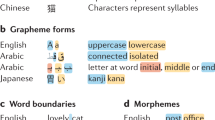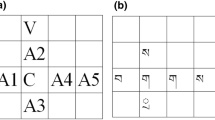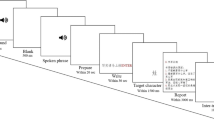Abstract
The paper describes four writing systems and a few example scripts under each system. Under the heading “Research Common to Different Scripts,” the paper then discusses research on phonetic coding, eye movements in reading, and cortical processing, in English, Chinese, Japanese, and Korean scripts. Under the heading “Research Unique to Specific Scripts,” it discusses research on word recognition in English orthography, in Japanese Kanji and Kana, and in Korean Hangul. Linguistic, cognitive, and cortical processing seems to be similar for people reading sentences and text in different scripts; processing seems to be dissimilar for people recognizing individual symbols in different scripts.
Similar content being viewed by others
References
Adams, M. J., & Huggins, A.W.F. (1985). The growth of children's sight vocabulary: A quick test with educational and theoretical implications.Reading Research Quarterly 20 262–282.
Baddeley, A. D., & Lewis, V. L. (1981). Inner active processes in reading: The inner voice, the inner ear, and the inner eye. In A. M. Lesgold & C. A. Perfetti (Eds.),Interactive processes in reading. Hillsdale, NJ: Lawrence Erlbaum Associates.
Bliss, C. K. (1965).Semantography (2nd ed.). Sydney, Australia: Semantography.
Bloomfield, L., & Barnhart, C. L. (1961).Let's read. A linguistic approach. Detroit: Wayne State University Press.
Chao, Y.-R. (1968).A grammar of spoken Chinese. Berkeley & Los Angeles: University of California Press.
Conrad, R. (1964). Acoustic confusion in immediate memory.British Journal of Psychology 55 75–84.
Fukuzawa, S. (1968). Developmental study on the factors of the difficulty in reading Kanji.Science of Reading 11 16–21 (in Japanese with English summary).
Gur, R. C., Gur, R. E., Obrist, W. D., Hungerbuhler, J. P., Younkin, D., Rosen, A. D., Skilnick, B. E., & Reirich, M. (1982). Sex and handedness differences in cerebral blood flow during rest and cognitive activity.Science 217 659–661.
Gazzaniga, M. S. (1983). Right hemisphere language following brain bisection (a 20-year perspective).American Psychologist 38 525–549.
Hatta, T. (1978). Recognition of Japanese Kanji and Hirakana in the left and right visual fields.Japanese Psychological Research 20 51–59.
Jensen, A. (1970).Sign, symbol and script. London: George Allen & Unwin.
Just, M. A., & Carpenter, P. A. (1980). A theory of reading: From eye fixations to comprehension.Psychological Review 87 329–354.
Kates, B., MacNaughton, S., Silverman, H. (1978).Handbook of Blissymbolics. Toronto: Blissymbol Communications Institute.
Kawai, Y. (1966). Physical complexity of the Chinese letters and learning to read it.Japanese Journal of Educational Psychology 16 129–138 (in Japanese).
Kratochvil, P. (1968).The Chinese language today. London: Hutchinson.
Maddieson, I. (1984).Patterns of sound. New York: Cambridge University Press.
Nishikawa, Y., & Niina, S. (1981). Modes of information processing underlying hemispheric functional differences.Japanese Journal of Psychology 51 335–342 (in Japanese with English abstract).
Ogden, J. A. (1984). Dyslexia in a right-handed patient with a posterior lesion of the right cerebral hemisphere.Neuropsychologia 22 265–280.
Paradis, M., Hagiwara, H., & Hildebrandt, N. (1985).Neurolinguistic aspects of the Japanese writing system. New York: Academic Press.
Sakamoto, T., & Makita, K. (1973). Japan. In J. Downing (Ed.),Comparative reading. New York: Macmillan.
Stern, J. A. (1978). Eye movements, reading, and cognition. In J. W. Senders, D. F. Fisher, & R. A. Monty (Eds.),Eye movements and higher psychological functions (Vol. 2). Hillsdale, NJ: Lawrence Erlbaum Associates.
Tanaka, T., & Yasufuka, J. (1975). Development of the cognition of letters (2).Osaka University of Education Report 24 85–99 (in Japanese with English abstract).
Taylor, I. (1980). The Korean writing system: An alphabet? a syllabary? a logography? In P. A. Kolers, M. E. Wrolstad, & H. Bouma (Eds.),Processing of visible language (Vol. 2). New York: Plenum.
Taylor, I. (1986a). The variety of scripts and reading.Proceedings of the 12th annual symposium of the Deseret Language and Linguistic Society. Provo, Utah: Brigham Young University.
Taylor, I. (1986b). Research on the variety of scripts.Proceedings of the 12th annual symposium of the Deseret Language and Linguistic Society. Provo, Utah: Brigham Young University.
Taylor, I., & Taylor, M. M. (1983).The psychology of reading. New York: Academic Press.
Tzeng, O. J. L., Hung, D. L., & Wang, S.-Y. (1977). Speech recoding in reading Chinese characters.Journal of Experimental Psychology: Human Learning and Memory 3 621–630.
Tzeng, O.J.L., Hung, D. L., Cotton, B., & Wang, W.S.-Y. (1979). Visual lateralization effects in reading Chinese characters.Nature 282 499–501.
Zaidel, E. (1978a). Lexical organization in the right hemisphere. In P. A. Buser & A. Rougeul-Buser (Eds.),Cerebral correlates of conscious experience. (INSERM Symposium No. 6). Amsterdam: Elsevier/North Holland Biomedical Press.
Zaidel, E. (1978b). Concepts of cerebral dominance in the split brain. In P. A. Buser & A. Rougeul-Buser (Eds.),Cerebral correlates of conscious experience. (INSERM Symposium No. 6). Amsterdam: Elsevier/North Holland Biomedical Press.
Zaidel, E. (1983). A response to Gazzaniga: Learning in the right hemisphere, converging perspectives.American Psychologist 38 342–346.
Author information
Authors and Affiliations
Additional information
This paper is based on the keynote address and the seminar given at the 12th annual symposium of the Deseret Language and Linguistic Society, February, 1986, Provo, Utah; published in the proceedings of the symposium and reproduced by permission.
Rights and permissions
About this article
Cite this article
Taylor, I. Scripts and reading research. Interchange 18, 78–88 (1987). https://doi.org/10.1007/BF01807061
Issue Date:
DOI: https://doi.org/10.1007/BF01807061




